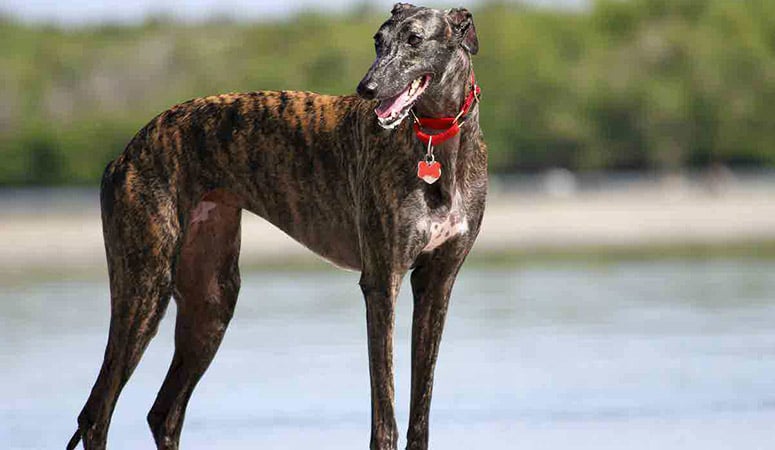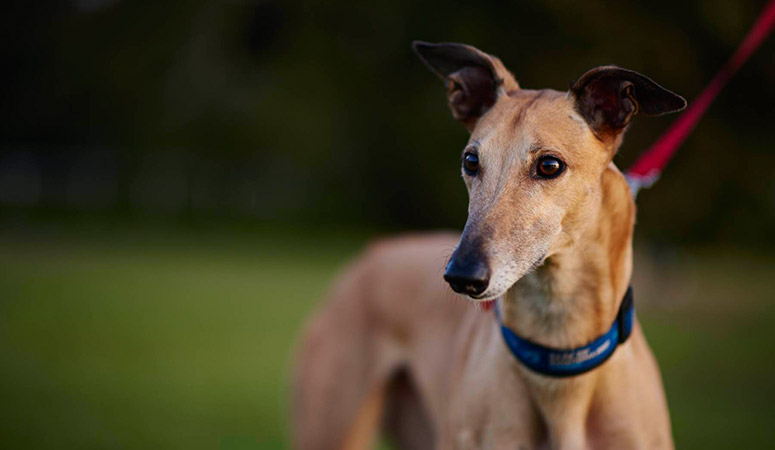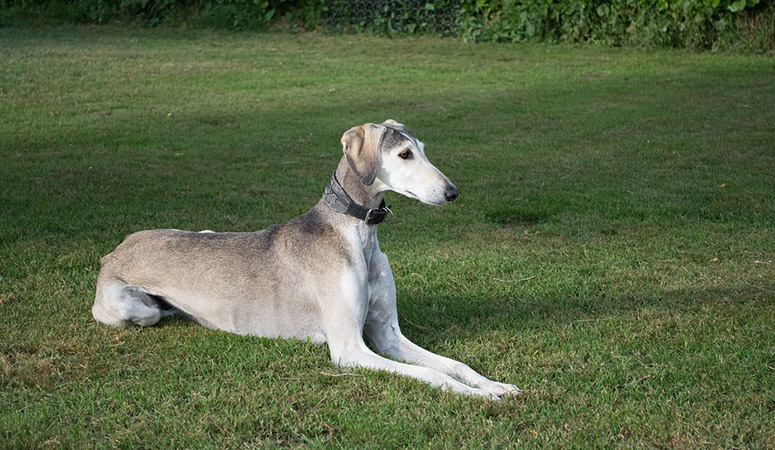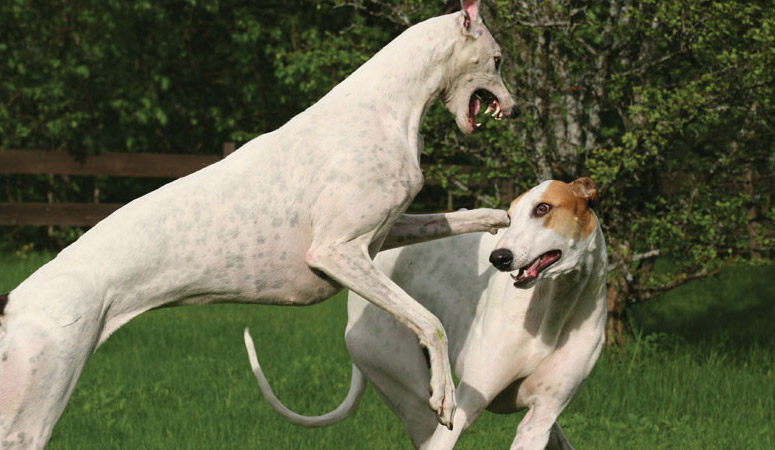Greyhound

Gentle, noble, and sweet-tempered, with an independent spirit, the Greyhound is the champion sprinter of dogdom. They were originally bred as hunting dogs to chase hare, foxes, and deer. Since the rise in large-scale adoption of retired racing Greyhounds, the breed has seen a resurgence in popularity as a family pet.
| Other Names | English GreyHound |
| Color | Black, Blue, Gray, Red, White |
| Height | Males: 27-30 inches. Females: 26-28 inches. |
| Weight | Males: 65-75 pounds. Females: 60-70 pounds. |
| Life Span | 10-13 years |
| Personality | Gentle, Independent, Noble |
| Exercise | Energetic |
| Origin |
| Popularity | #162 |
| Groom Needs | Occasional |
| Kids Friendly | Yes with supervision |
| Dog Friendly | Yes |
| Watch Dog | |
| Family Dog | |
| Litter Size | 1-12 |
Greyhound Pictures
Greyhound Video
Introduction
Greyhounds can get very hyperactive as puppies unless they are properly trained. Adult Greyhounds are generally docile, gentle, and amiable, not without a tendency to be lazy. They are passionate about their family and are more inclined to stand aloof to a stranger. They come in a short coat of many color varieties, mainly including black, fawn, white, blue and brindle or even discrete combinations of the above colors. Their long and powerful legs steadied to a flexible spine, come handy especially when they sprint in such explosive speed as they are known for.
A male Greyhound is likely to stand 28-30 inches tall, from shoulder to paw, and tip the weighing scales towards 70 pounds. The females run smaller and measure between 25 and 28 inches at the shoulder. Full-grown females weigh 60-65 pounds. The Greyhound, in the course of history, has dined with kings and commons alike, established a sprinting career for the records, and still remains a relevant house dog. On average, they live up to 9-13 years.
Living with Greyhound
Greyhounds have a short, smooth coat that is simple to groom. The owner needs to brush the dog’s coat every week with a hound mitt or rubber curry brush to remove dead hair and distribute skin oils that keep the coat shiny. Bathe as needed, and using a dry shampoo to keep his coat clean and smelling great.
Check your dog’s ears once a week for the signs of infection, irritation, or wax buildup. And this breed’s teeth need the most dedicated care, they tend to have poor dental health. Brush the teeth at least two or three times a week to prevent tartar buildup and gum disease. The rest is to trim the nails once or twice a month if your dog doesn’t wear them down naturally to prevent painful tears and other problems.
Greyhounds are not very high energy dogs, but they should have regular opportunities to run free on open ground in a safe area, as well as daily long, brisk walks, where the dog is made to heel beside or behind the person holding the lead. They can be quiet house dogs as long as given proper exercise, without enough exercise, they may become bored which may lead to destructive behaviors. They would be happy to lounge around the house all day, but with the inborn drive to chase prey, the Greyhounds need to be in a solid fenced to prevent chasing after small animals.
The breed typically requires somewhat higher calories and protein than some dogs. Feeding the Greyhound a high-quality dog food should depend on the dog’s weight, size, age, and activity level.
Some dogs are easy to get overweight, so you need to watch their calorie consumption and weight level all the time. Treats may be an important aid in training, but excessive intake can lead to obesity. Also, owners need to distinguish which human food is safe for dogs and which are not. If you have any problems with your dog’s weight or diet, just consult from your veterinarian.
The Greyhounds are prone to the following health conditions: Bloat (Gastric Dilatation and Volvulus), Hypothyroidism, Osteosarcoma (bone cancer), hypertension, arthritis, Anesthesia Sensitivity, supernumerary teeth, chronic Sesamoiditis, etc.
Major concerns: osteosarcoma
Minor concerns: gastric torsion, esophageal achalasia
Occasionally seen: DCM, SAS, osteogenesis imperfecta
Suggested tests:
Cardiac Exam
Ophthalmologist Evaluation
Greyhound Polyneuropathy NDRG1 DNA Test
Total Annual Cost: $3235
Cost is estimated for the first year and may vary depending on many factors, such as dog food, health care, leash, collar, licensing, possible fencing, crates, training and obedience classes, dog-walking, grooming, treats, toys, flea, tick, and heart-worm meds, microchips, etc.
As a sighthound or coursing breed, the Greyhound was developed to pursue game by sight rather than by scent. Unlike other types of hunting breeds that require a bit of direction, Greyhound course game independently of humans and make decisions on their own. And it is suggested to expose them to many different people, places, and situations to get socialization and prevent them from becoming timid or fearful. Many obedience schools offer socialization classes, which are also a wonderful start to obedience basics. They are very affectionate with their families, though they tend to be reserved with strangers. Greyhounds need a gentle approach in training than harsh punishment because of their mild and sensitive personality.
History
The Greyhound is a popular racing and coursing dog as the world knows. It has a long reputation for events that involved sprinting and chasing games, but results of modern DNA sequencing have repeatedly pointed towards a herding bloodline. The Greyhound is an ancient breed that had probably originated amongst ancient Egyptian monarchs, who held them in the sacrilege of sorts. Some historians claim that Greyhounds were easy favorites with the Pharaohs for their elegance and regal stature. Archaeological excavations in the Tell Brak region of Syria had discovered skeletons of a dog which looks like a Greyhound or a Saluki and has been dated back to about 4000 years ago. The Saluki and the Greyhound share a similarity in stature and perhaps ancestry, some reports speculate.
Another report puts it this way– records from examining the earliest sighthounds spotted in the United Kingdom, which was probably ancestors of the Greyhound, suggest that they had an origin from the Celts of Eastern Europe– however recent studies have failed to be consistent with this report as there’s no evidence of Greyhounds in Europe before the Roman invasion. The Greyhounds stock was initially recorded in private studbooks in the 1700s and later in public studbooks in the 1800s, and all modern pedigree stems from these records.
The Greyhound was brought into the United States by British immigrants. It didn’t take long for the Greyhound to set up a reputation for racing and coursing, even in the Midwest. It was recognized by the American Kennel Club (AKC) in 1885, alongside 14 other breeds.
Helpful Information
Breed Club: GREYHOUND CLUB OF AMERICA
Breed Club Link: https://www.greyhoundclubofamericainc.org/
Breed Club Rescue:
Breed Club Rescue Link: https://www.greyhoundclubofamericainc.org/rescue-gcoa/



